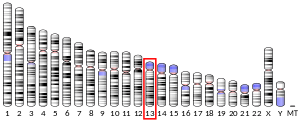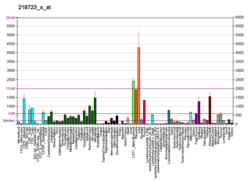Regulator of cell cycle RGCC
Regulator of cell cycle RGCC (RGCC) also known as response gene to complement 32 protein (RGC-32) is a protein that in humans is encoded by the RGCC gene.[5][6][7]
Function
This gene is thought to regulate cell cycle progression. It is induced by p53 in response to DNA damage, or by sublytic levels of complement system proteins that result in activation of the cell cycle. The encoded protein localizes to the cytoplasm during interphase and to centrosomes during mitosis. The protein forms a complex with polo-like kinase 1. The protein also translocates to the nucleus in response to treatment with complement system proteins, and can associate with and increase the kinase activity of cell division cycle 2 protein. In different assays and cell types, overexpression of this protein has been shown to activate or suppress cell cycle progression.[7]
References
- 1 2 3 GRCh38: Ensembl release 89: ENSG00000102760 - Ensembl, May 2017
- 1 2 3 GRCm38: Ensembl release 89: ENSMUSG00000022018 - Ensembl, May 2017
- ↑ "Human PubMed Reference:".
- ↑ "Mouse PubMed Reference:".
- ↑ Saigusa K, Imoto I, Tanikawa C, Aoyagi M, Ohno K, Nakamura Y, Inazawa J (Feb 2007). "RGC32, a novel p53-inducible gene, is located on centrosomes during mitosis and results in G2/M arrest". Oncogene. 26 (8): 1110–21. doi:10.1038/sj.onc.1210148. PMID 17146433.
- ↑ Huang WY, Li ZG, Rus H, Wang X, Jose PA, Chen SY (Mar 2009). "RGC-32 mediates transforming growth factor-beta-induced epithelial-mesenchymal transition in human renal proximal tubular cells". J Biol Chem. 284 (14): 9426–32. doi:10.1074/jbc.M900039200. PMC 2666595. PMID 19158077.
- 1 2 "Entrez Gene: RGC32 response gene to complement 32".
Further reading
- Fosbrink M, Niculescu F, Rus H (2005). "The role of c5b-9 terminal complement complex in activation of the cell cycle and transcription". Immunol. Res. 31 (1): 37–46. doi:10.1385/IR:31:1:37. PMID 15591621.
- Bonaldo MF, Lennon G, Soares MB (1997). "Normalization and subtraction: two approaches to facilitate gene discovery". Genome Res. 6 (9): 791–806. doi:10.1101/gr.6.9.791. PMID 8889548.
- Badea TC, Niculescu FI, Soane L, et al. (1998). "Molecular cloning and characterization of RGC-32, a novel gene induced by complement activation in oligodendrocytes". J. Biol. Chem. 273 (41): 26977–81. doi:10.1074/jbc.273.41.26977. PMID 9756947.
- Badea T, Niculescu F, Soane L, et al. (2002). "RGC-32 increases p34CDC2 kinase activity and entry of aortic smooth muscle cells into S-phase". J. Biol. Chem. 277 (1): 502–8. doi:10.1074/jbc.M109354200. PMID 11687586.
- Ota T, Suzuki Y, Nishikawa T, et al. (2004). "Complete sequencing and characterization of 21,243 full-length human cDNAs". Nat. Genet. 36 (1): 40–5. doi:10.1038/ng1285. PMID 14702039.
- Fosbrink M, Cudrici C, Niculescu F, et al. (2005). "Overexpression of RGC-32 in colon cancer and other tumors". Exp. Mol. Pathol. 78 (2): 116–22. doi:10.1016/j.yexmp.2004.11.001. PMID 15713436.
- Tanaka T, Takada H, Nomura A, et al. (2005). "Distinct gene expression patterns of peripheral blood cells in hyper-IgE syndrome". Clin. Exp. Immunol. 140 (3): 524–31. doi:10.1111/j.1365-2249.2005.02805.x. PMC 1809394. PMID 15932515.
- Olsen JV, Blagoev B, Gnad F, et al. (2006). "Global, in vivo, and site-specific phosphorylation dynamics in signaling networks". Cell. 127 (3): 635–48. doi:10.1016/j.cell.2006.09.026. PMID 17081983.




